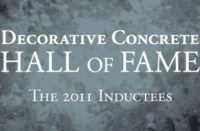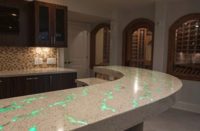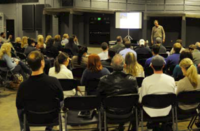If you think you’ve got fastidious clients who want a particular shade of this and just the right texture of that, hold on to your mouse ears. As sure as supercalifragilistic-expialidocious is the longest word in the English language, few people are as meticulous as the folks at Disney.
If you think you’ve got fastidious clients who want a particular shade of this and just the right texture of that, hold on to your mouse ears. As sure as supercalifragilistic-expialidocious is the longest word in the English language, few people are as meticulous as the folks at Disney.
For example, let’s take the courtyard between the large likenesses of Lady and the Tramp at the new Disney’s Pop Century Resort in Orlando, Florida. “We were given a tape of the movie and were told to watch it,” says Steve Martin, regional manager of key accounts for L.M. Scofield Company, which supplied much of the stains, color hardeners, stamping tools, skins and other incidentals that were used to create the hardscapes at the resort. “All the colors and textures used for that streetscape were taken from that film. They had to match exactly.”
To create Animal Kingdom, which features a safari ride, Martin says he was given five samples of dirt from the Serengeti, a plain in northwest Tanzania where there is a large wildlife reserve. Scofield developed custom-matched color hardeners and also matched the textures with concrete to make the park’s hardscapes look like rugged terrain.
And, unless someone pointed it out, you probably had no idea it wasn’t. The rudimentary-looking roadways have ruts, dips and deep tire tracks. “On the safari ride, the trucks are riding on cast-in-place concrete, not mud,” Martin says. Joe Rhody, the lead designer for Disney, dubbed the rustic concrete “designer dirt.”
Martin says he and others involved with Disney projects work closely with the Imagineering team — the master planning, creative development, design, engineering, production, project management and research and development arm of The Walt Disney Co. In short, Martin explains, “They’re Disney’s think tank.”
From concept through installation, they’re the ones behind the creation of all Disney resorts, theme parks and attractions, real estate developments, regional entertainment venues and new media projects. And, above all, “Those guys are all about detail. Everything has to be just so,” he says.
The scoop on Pop Century
According to Jeff Kelly, a project manager with Centex Rooney who served as assistant project manager on the Pop Century Resort project, 124 colors and 45 custom-matched caulk colors were used to complete the hardscape for Phase I of the resort, which focuses on the pop culture of each decade of the last 50 years of the 20th century. (No timetable has been set to begin Phase II, which will highlight the 1900s through the 1940s.)
Of the wide array of colors used, “I’d say 15 to 20 colors were off-the-shelf Scofield colors,” Kelly estimates. “The rest were custom matched to color chips” or to specific shades on the Pantone color key.
Ground was broken on Phase I of the Pop Century project in June 1999 and completed in April 2002. Between April 2001 and April 2002, Kelly says, they poured just over 9,000 cubic yards and hand finished 450,000 square feet of concrete. Of the overall $128 million contract, $3.4 million was devoted to the hardscape package.
Phase I of Pop Century included 10 lodge buildings and 2,880 rooms, six pool buildings and four pools — one shaped like a bowling pin in the ’50s section, another like a flower from the ’60s complemented by a sunflower-shaped kiddy pool, and the fourth in the shape of an ’80s computer monitor. “We raised the pool deck and used a resilient-rubber material to make a giant keyboard,” Kelly says.
Whereas a giant ’70s foosball table highlights Kelly’s favorite courtyard, the bowling lanes near the pin pool had to be the most intense part of the project and are the creation of which he is most proud.
“Disney wanted the pool deck to look like a waxed floor and the relief had to be very shallow,” he remembers. “The stamping was so finite. It’s within a 1⁄4 inch and the shallowest stamp Scofield has ever made.” Since the crew only had a small window of time, “like 20 minutes,” to do the job right, “we broke up the pool deck into 100 different pours. If you look real close, you can see the construction joints.”
Kelly says they had 11 different sets of stamps set up in sequence to control the finite stamping process, and the whole crew had to pitch in and stamp to get the appropriate relief on the pool deck. As if this wasn’t problematic enough, it turned out to be one of the wettest years they’ve ever had in Orlando, Kelly says, adding that it’s typical for it to rain around noon every day during the summer anyway. In order to have the concrete set up before it rained, crews had to start work in the middle of the night — a normal workday ran from 2 a.m. to 11 a.m. — with artificial lighting from light towers glaring down on them much of the time.
Kelly says because a lot of the concrete was integrally colored, they used a conveyor with a telescopic boom to place the concrete. The water necessary to use with a pump would have jeopardized the consistency of the color, he adds.
“The whole job took a massive amount of preplanning,” Kelly says. “Without the great supers we had, we wouldn’t have been able to pull it off.”

The wild happenings at Animal Kingdom
Earl “Honk” Visger, currently hardscape division manager for D&D Tree in Lake Buena Vista, Fla., has worked on numerous Disney projects since 1990. For three years, as the hardscape super for a company called Valley Crest, he helped build Animal Kingdom — literally from the ground up.
For starters, the area where the park now stands was leveled, and everything — every shrub and tree, every hill and dale — was strategically placed according to a master plan. “It was the most challenging job I’ve ever been involved with, completely different from anything I was ever taught,” Visger says. “We threw away everything we knew and started experimenting.”
All the walks were shovel cut; they didn’t use any forms. For the first time in his experience, Visger recounts, he fashioned concrete to look like wood. They made many of their own stamps to resemble dirt, forest litter or a combination of both. They made giant root skins and root molds from actual tree parts. Near big trees, they placed concrete roots to make them look like they were jutting out of the walkway. “Some people actually try to pick them up. That’s how real they look,” he says.
The crews ran barefoot through the cement mud to mimic fleeing “aborigines.” Some guys were wrapped in plastic and rolled around to create imprints that looked like the result of large wallowing beasts. Others strapped three-gallon buckets on their feet and ran to create elephant footprints. Still others were dragged away from the mud into the brush, similar to what a lion would do with its kill. “We did a lot of strange stuff,” Visger recalls. “It was a wild job.”
Wild, indeed. When the safari animals were first brought to Animal Kingdom, he explains, they had to be trained to go into their houses to sleep at night and most of them weren’t fast learners. There were many hairy nights when Visger and his crew were pouring the ride paths and had to scramble to safety.
“We’d be pouring concrete and if an animal keeper blew his whistle, we went and jumped in our trucks, no questions asked. Then we’d see a herd of wildebeest or ostriches or zebras run by. It’d happen a couple of times each night.”
Visger, who was known as Honky before his first Disney employers emphatically recommended he shorten his nickname to Honk so many years ago, credits Disney with high standards and a penchant for quality work. “If you do things right you can be a household name,” he says. “If you don’t, you’re out of there.”


























